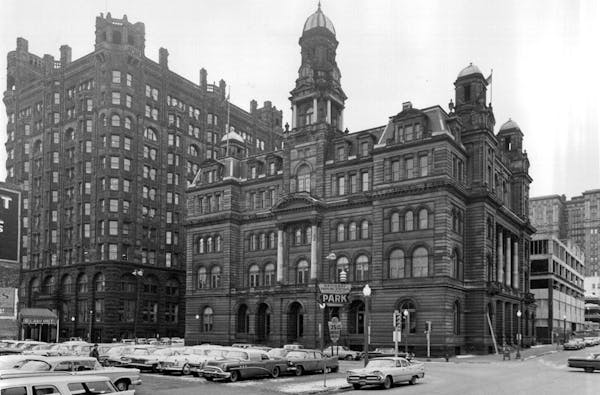Close your eyes and imagine downtown Minneapolis. What's missing?
Parking, you might say. Granted. But something else is largely absent, something that's found in every other neighborhood.
Utility poles and their attendant wires.
Never noticed that before, eh? But it wasn't always so.
In the early days of the city, the streets bristled with poles carrying dozens of wires. A late-19th-century civic improvement project put them underground, in tunnels that were called "the subway."
There was some early talk about building an actual subway — an underground commuter rail line — in the Twin Cities, however.
In April 1907, the Minneapolis Tribune had a small notice (on page 7) of a remarkable plan:
"Plans for the Minneapolis subway are rapidly nearing completion. Official announcement can be expected shortly. Two or three railroads are said to be back of the project and they are willing to spend approximately $600,000 to secure what they want."
And then … nothing.
It wasn't mentioned again. A plan that would have changed the entire city just evaporated. The only references in the paper's archives to a subway were letters to the editor wondering why we didn't have a subway.
Why didn't we? And what would the Twin Cities be like if we had?
Consider the latter question first. If a subway system had been built in 1907, the stations would have been gleaming white with terra-cotta tiles, with elegant signage and classical details. Of course, the system would have gotten dingy by the 1940s, and been hideously modernized in the '50s.
How big would it have gotten? Would it have been extended beyond the small core of the city? If not, it would have likely been extended to the suburbs in the '70s, with gloomy concrete stations that terminated at the Richfield and Roseville borders.
A subway system would have nixed light rail. That means we'd now be talking about drilling new lines to the exurbs. But that might be less controversial than light rail. Subway systems don't disrupt the surface environment like light rail, to state the blindingly obvious. And subways are simply more impressive than streetcars or light rail.
Buses are like clambering onto an oxcart. Subways are a high-speed voyage through an underground world.
The magic wears off, of course. You get annoyed with them, especially if the system's underfunded and the decay degrades the experience.
New York, whose subway is woven into the city's life, is watching its system fall apart again, just as it did in the '70s, when every car was smothered with feral scrawlings, every station an affront to the nostrils.
On my last visit, I entered a subway station that was boiling hot, smelly, humid; half of the ticket machines didn't work, and there was a busker with an electric guitar playing some deafening racket for donations. It was the sort of everyday hell New Yorkers pride themselves on enduring, for some reason.
We left and Ubered.
Would a Twin Cities subway have been like that? No.
Would it be like the metro in Russia's St. Petersburg?
That subway is old, harshly lit and loud. The cars rattle with a deafening fury. But the stations are impressive, decorated with Soviet remnants that remind you of the authoritarian state that built them. Hammers and sickles everywhere, like signs of a religion that went out of business.
Ours would not be so strenuously grand. Perhaps we could've had something with Parisian sophistication, something you can ascribe mostly to the signage. In Paris, the subway signs have an Art Nouveau typeface that makes you think you've time-traveled back to the City of Light in 1895 — an illusion that's hard to maintain when the guy at the back of the car is playing Michael Jackson's "Thriller" on a boombox at 140 decibels while staring angrily into space.
If our subway had a distinctive typeface, proud locals would be wearing it on T-shirts. Stores at the airport would sell mugs with our subway's logo.
Ah, if only. But it didn't happen. Why?
There wasn't any reason to build one. Certainly not in 1907.
Subways are for dense cities. Back then, both Minneapolis and St. Paul were streetcar towns, with toddling trolleys that rattled along arteries lined with low-slung apartment buildings and single-family neighborhoods.
In a perfect world of unlimited funds and foresighted planners, we'd have a subway system that goes from City Hall to Southdale; from Maplewood to the Mall of America. Heck, from Linden Hills to Uptown. (A short jaunt, admittedly, but a great way to go if you want to have dinner and not try to find parking.)
Our subway system would have provided an experience that no other form of public transportation can give you.
There's the quiet peace of the platform, the accumulating sound of the approaching train, the sense of the air pressure changing as the train appears; the whoosh, the wind, the screech, the stop. There's the mild combat of getting off before the doors close — and the doors will close, without regard for life or limb.
It's all that, but there's something else we'll never know.
Rising up from the depths on an escalator into the surface. You've been sped through a hole in the dark Earth, then you ascend into the light.
We'd be a different place if we had a subway. Hard to argue that we wouldn't be better. What happened in 1907 that killed the plans? It's likely they came to their senses.
Alas.
James Lileks • 612-673-7858 • @Lileks






